The foremost and largest state in India maintains international acclaim for its extensive cultural legacy combined with numerous distinctive artistic expressions. Uttar Pradesh functions as a living center for traditional handicrafts which demonstrate the distinctive talents and historical traditions of its skilled makers. Uttar Pradesh presents an extensive selection of handcrafted items including complicated textiles and exquisite pottery pieces which attract international visitors. This article delves into the various art forms of Uttar Pradesh, highlighting their significance and beauty.
The artistic heritage of Uttar Pradesh draws its main inspiration from the Mughal era because this period introduced numerous handicrafts to the region. LocalDateTime of practice by its artisans has turned Uttar Pradesh into a prominent handicrafts hub of India. The state’s contribution to the country’s handicraft exports is substantial, with a significant portion coming from carpets, leather goods, and metalware.
Pottery
Uttar Pradesh holds a position as one of the most ancient and extensive areas for pottery production throughout the state. The production of pottery in Uttar Pradesh began during the Indus Valley Civilization period when archaeological findings were discovered specifically at Alamgirpur near Meerut. Glazed pottery with blue and green patterns on white backgrounds creates fame for Khurja along with Chunar and Rampur. Members of the Khurja potter community have mastered their craft through generations and produce affordable domestic items including the Surahi vessel used for keeping water cold. The intricate pottery tradition has existed in Uttar Pradesh cultures for about 600 years probably beginning with the era of the Mughals.

Uttar Pradesh’s pottery serves decorative functions beyond functionality after artisans craft beautiful floral and patterned ornamentations. Uttar Pradesh pottery reaches high demand in domestic and international markets because of its distinctive color usage and special crafting techniques. Besides Chunar black clay pottery, Nizamabad people know that black clay city produces remarkable shining wares by applying special finishing powder derived from rice field soil.
Glassware
Glassware stands as a main Uttar Pradesh handicraft that generates most of its activity through the three major glass centers of Firozabad, Varanasi, and Saharanpur. Firozabad is famously known as the “City of Bangles” due to its extensive production of colorful glass bangles. The glass bead industry of Varanasi generates national and international demand due to their applications in jewelry and decorative pieces. Local artisans in Uttar Pradesh adopted glassmaking by processing foreign glass items that foreign invaders brought into the region.
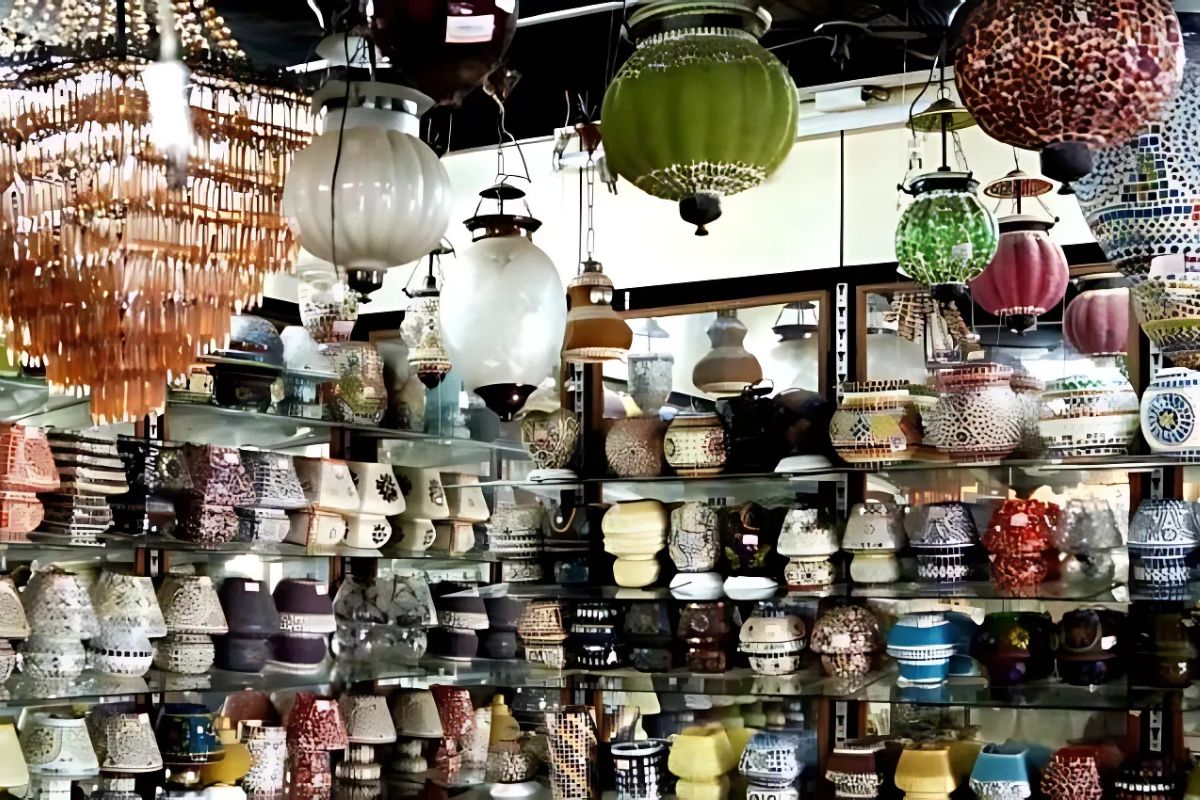
The glass products of Uttar Pradesh include chandeliers together with jewelry and decanters joined by small decorative objects. Cunning artisans employ comprehensive techniques to produce glass items of quality by shaping raw materials into lasting works of art. The glass bangles produced in Firozabad stand out because of their famous colorful designs which draw many tourists as souvenir purchases.
Perfumes
Far back in time Uttar Pradesh has produced sought-after perfumes especially the ones from Kannauj. As the perfume capital of India Kannauj produces its fragrances through traditional methods following historical production techniques of high quality. Perfumery in Kannauj follows a process of essential oil extraction from flowers combined with herbs to generate distinct and appealing scents.

People from both domestic and international markets chase Kannauj perfumes because of their distinctive strength and purity. Traditional methods of perfumery have survived since generations to protect both the fragrance quality and its initial authenticity. Visitors to Uttar Pradesh often look forward to experiencing the rich aromas of Kannauj’s perfumes, which are an integral part of the state’s cultural heritage.
Zari Embroidery
Uttar Pradesh presents Zari embroidery as its most sophisticated craft work through the application of gold and silver threads for elaborate fabric designs. Uttar Pradesh received this artistic tradition from Turko-Afghan Sultans during the 12th century and Varanasi, Agra and Lucknow became notable centers for its practice. Precious gems such as diamonds and emeralds along with pearls are commonly integrated into the three-dimensional Zari work patterns.
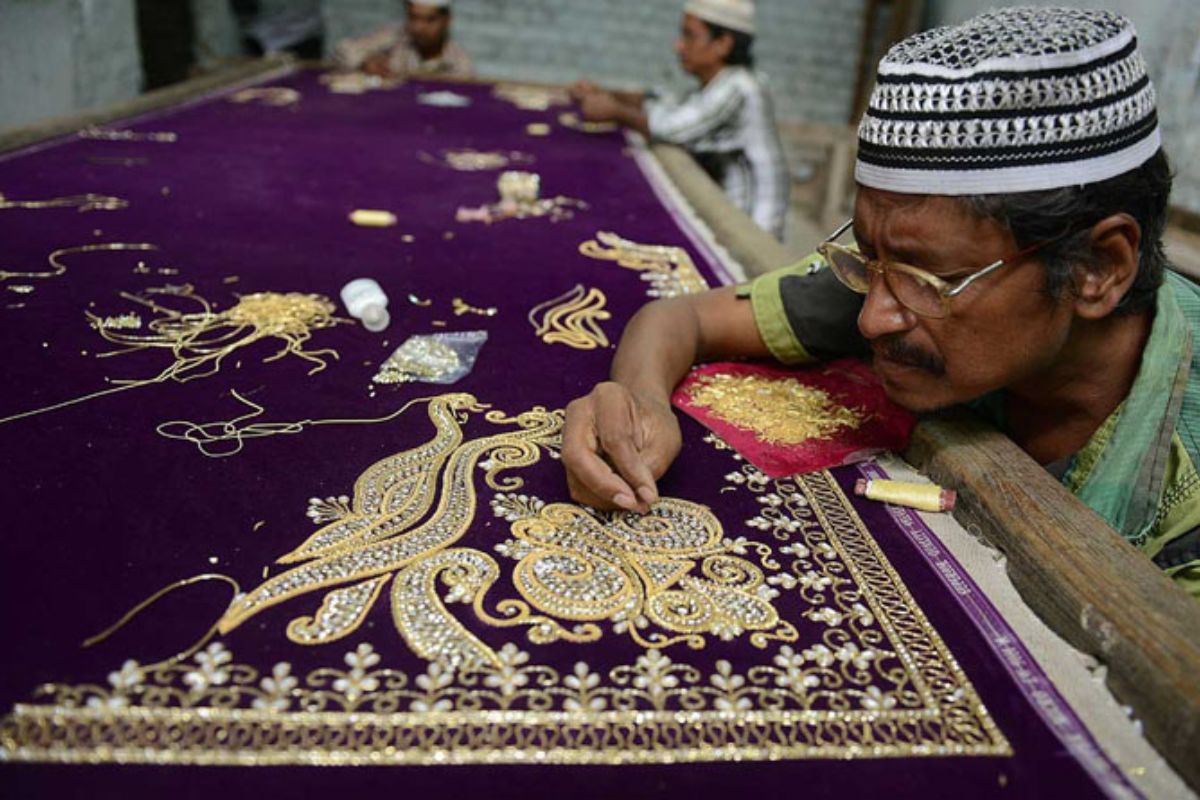
The creations from Zari embroidery consist of luxurious garments as well as drapes alongside decorative products that showcase the magnificence of this art form. Silk threads plaited with copper and gold plating enhance Zari embroidery so this work receives high value for its aesthetic attributes and skilled execution. Zari work present in Banarasi sarees manufactured in Varanasi fame the garments with a noble and lavish finish.
Metalware
Uttar Pradesh claims fame through its metalware while Moradabad functions as the main brass metal crafts manufacturing hub of the state. The city earns its fame through exquisite brass products that include decorative items composed of vases, trays and religious gods and goddess idols. Artists use two methods in metalwork: Khudai and Nakashi engraving for designing complex patterns.

Moradabad’s metalware products maintain multiple benefits as they prove durable and beautiful so customers regularly buy them for domestic usage and worldwide export markets. Over multiple generations of artisans in Moradabad have achieved such mastery that each metal piece becomes an affirmation of their expertise. The city’s contribution to Uttar Pradesh’s handicraft exports is significant, highlighting the importance of metalware in the state’s cultural and economic landscape.
Hand Printing
The ancient Indian craft of hand printing maintains Uttar Pradesh as its primary hub for this artistic tradition. Farrukhabad along with Lucknow and Varanasi together with Pilkhuwa create their reputation through hand-printed textile fabrics that display butis and Paisley patterns and the tree of life motif. Artists produce vibrant unique prints through wooden block designs that work with dark color choices.

The city of Farrukhabad established itself as a hand printing center at 1714 AD thus marking the beginning of this Uttar Pradesh craft. The hand printing art of Uttar Pradesh grew into numerous design options and production methods which now represent an essential cultural legacy of the state. Craftsmen who work at hand printing have maintained both the traditional techniques and this age-old craft which promises to continue for many eras.
Chikankari
Among the world’s superior embroidery Chikan Work remains famous under the name Chikankari embroidery specifically in Lucknow. The word “Chikan” means cloth wrought by needlework, and this craft involves 36 different types of stitches. Chikankari embroidery artists use silk and organza and chiffon fabrics to create their elaborate and beautiful needlework designs.
The handiwork of Chikankari first appeared during the time of Chandragupta Maurya followed by its promotion by Empress Nur Jahan who wedded Mughal Emperor Jahangir.

Chikanari craft production begins by making fabric cuts before printing blocks for designs that get covered with embroidery work. Embroiderers use five main stitches for their work which are Jali, Tepchi, Murri, Pashni, and Khatao. Lucknow Chikan sarees together with Chikan Kurtis are the most sought-after items for their intricate patterns and elegant royal appeal.
Zardozi
The region of Uttar Pradesh has another masterful hand art form called Zardozi which utilizes both silver and gold threads in metal embroidery creation. Embroidery crafts existed during Rigveda times thus making it among India’s longest existing decorative techniques. Products from Zardozi feature complex patterns that painters decorate with gold threads and gemstones and beads.
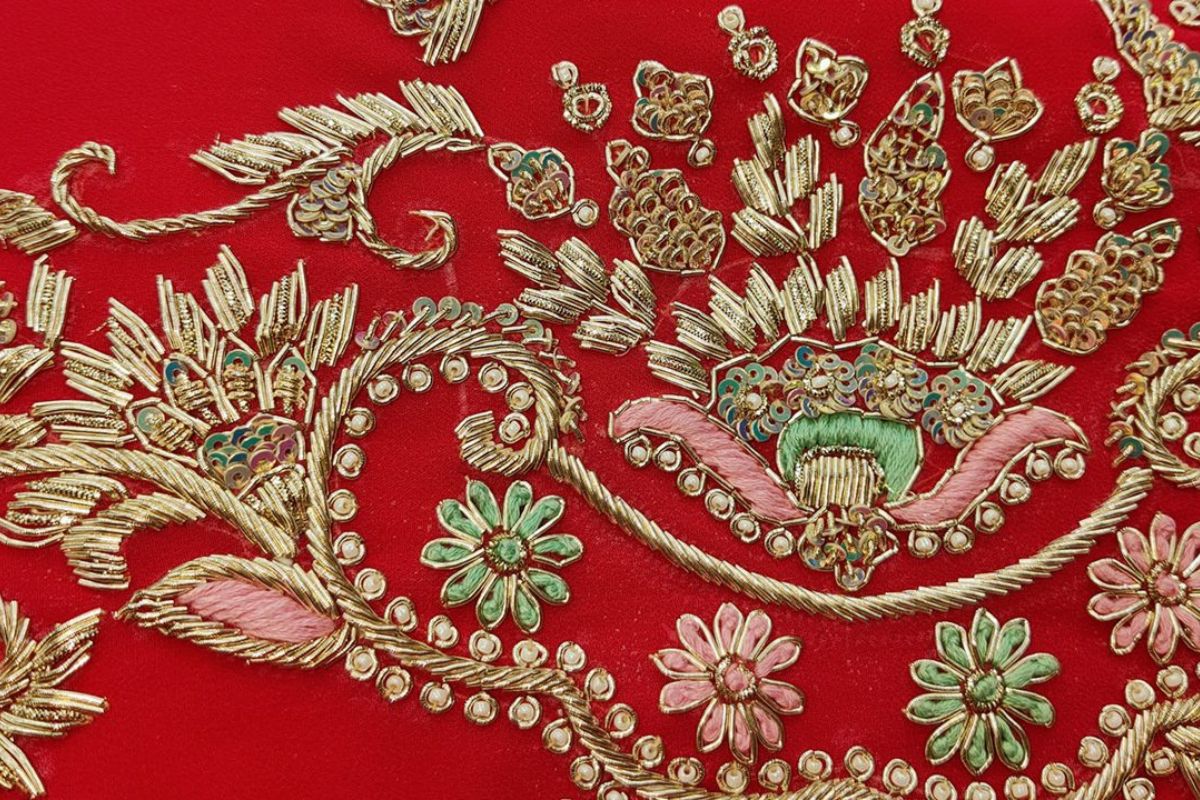
Zardozi embroidery requires complex production because artisans execute their work within a wooden frame with multiple necessary tools. Zardozi artists produce their intricate designs with the combination of needles, hooks along with glass and plastic beads and gold and silver wires. The cities of Lucknow together with Varanasi alongside Agra and Bareilly serve as major Zardozi centers that manufacture lavish drapes along with luxurious garments and complex decorative products.
Kathak
Among the classical dance forms found in Uttar Pradesh stands Kathak which belongs to the group of eight major classical Indian dances. Kathak began its development in Uttar Pradesh temple precincts where practitioners showcase quick footwork motions with complex hand movements. Vital to the historic culture of Uttar Pradesh is Kathak despite its widespread popularity across numerous regions of the state.

Through Hindu mythological narratives Kathak dancers present their interpretations by employing both their facial emotions and body expressions. Through time Kathak absorbed aesthetic features from both musical traditions and theatrical techniques. Kathak maintains key significance in Uttar Pradesh because the state functions as one of the major centers producing classical dance performances and training activities.
Carpet Weaving
In Uttar Pradesh hand-knotted carpet weaving stands as a major craft due to its prominence in the cities of Bhadohi and Mirzapur as well as Khamaria. Bhadohi meets almost the entire demand for carpets in India while creating carpets with colorful designs that feature Persian patterns. Handmade carpet quality relies on the number of knots per area and denser knots mean superior workmanship.

Due to their beautiful looks and sturdy durability Uttar Pradesh carpets attract enthusiastic buyers domestically and internationally. Through many generations of artisans’ skills have developed into a benchmark that highlights their mastery through every carpet creation. Artificial silk found in carpets has successfully become a preferred alternative when people wish to replace traditional Kashmiri silk carpets.
Embroidery Traditions
Chikankari and Zardozi together with other embroidery traditions find their home in Uttar Pradesh. The handiwork demonstrates both artistic splendor while representing the deep cultural heritage of Uttar Pradesh. The embroidery methods of Uttar Pradesh contain detailed decorative elements that take inspiration from Mughal decoration and building designs.

People deeply treasure the embroidery traditions throughout Uttar Pradesh because they showcase both exquisite craftsmanship and artistic beauty which preserves the essential heritage of the state. Craftspeople working in these traditions have preserved their practices so they will remain alive through the current and future generations. Various fabric choices and embroidery techniques have elevated Uttar Pradesh embroidery to international recognition.
Mughal Painting
During the Mughal period Uttar Pradesh demonstrated its rich cultural persona through Mughal painting which has become an essential art form of the region. The Mughal dynasty reached its maximum height in painting by creating delicate masterpieces with complicated designs and extensive detailing. Mughal artwork typically shows views from royal aspects together with hunting activities and battlefield scenes to display Mughal Empire magnificence.
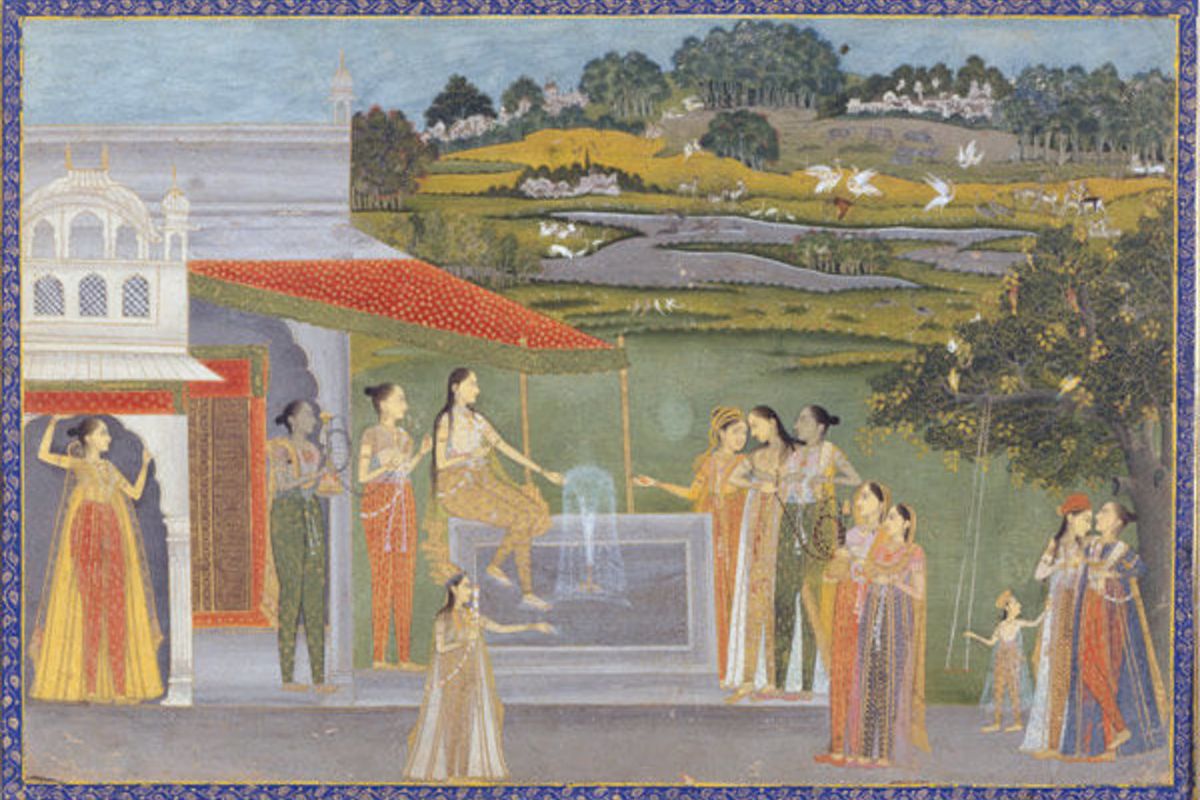
Mughal painting exerts an influence throughout Uttar Pradesh on both embroidery techniques and metalwork creation. Through years of dedicated practice Mughal artists have developed their artistic skills to maintain a level of beauty and lavishness in their creations. Many distinguished Mughal artists come from Uttar Pradesh as the state makes a substantial contribution to Mughal painting.
Stone-craft
The important art domain of Stone-craft exists in Uttar Pradesh particularly through Mathura and Varanasi where artistic sculptures emerge from red and cream sandstone. Since ancient times artisans of Uttar Pradesh have practiced stone sculpting which resulted in the creation of beautiful Hindu god sculptures along with sculptures of Buddha.
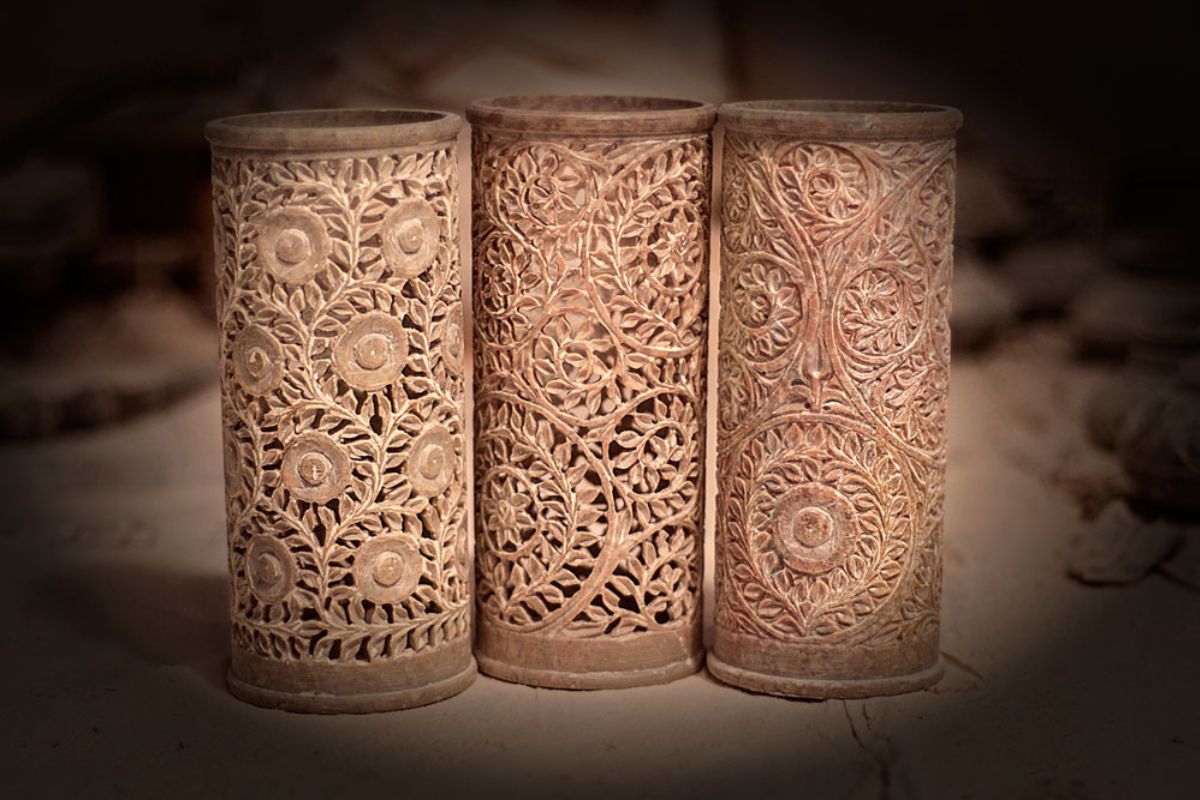
Marble stone craft experienced popularity throughout the Mughal period since artisans created elaborate decorative elements for landmarks such as the Taj Mahal. Artisans worked on pietra dura to create the inlay craft by inserting stones of different colors into bases where they carved grooves to reveal intricate designs of floral and geometric forms. Artists in Agra and Vrindavan establish global recognition for their stone craft which includes decorative vases and boxes as the principal products.
Conclusion
Uttar Pradesh exists as a valuable collection of traditional art forms which express both local heritage and skilled artisan workmanship. Throughout centuries these traditional arts have maintained their critical status as fundamental components which define Uttar Pradesh. The state’s contribution to India’s handicraft exports is substantial, highlighting the importance of these art forms in both cultural and economic terms. Uttar Pradesh serves as a culturally diverse artistic excellence destination that continues to mesmerize international visitors.
The economy of Uttar Pradesh depends on these traditional crafts because they maintain both traditional heritage and provide employment through thousands of artisans. Traditional arts continue to align with modern customer needs by retaining their original character which makes them competitive in current global markets. The state remains a vital force that strengthens India’s handicraft export industry due to the economic worth of traditional artistic expressions.
With each generation that passes on skills the artisans demonstrate their ancestral roots while showing the ability to adapt throughout the years. People who visit the state along with art enthusiasts come to explore this extraordinary craftsmanship while purchasing items that showcase this everlasting artistry.
Also Read: The Diverse and Unique Art Forms of Bengal
You can connect with DNN24 on Facebook, Twitter, and Instagram and subscribe to our YouTube channel.

